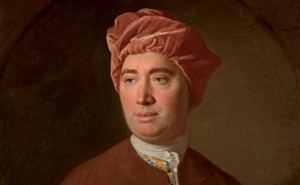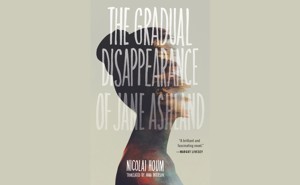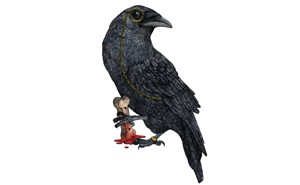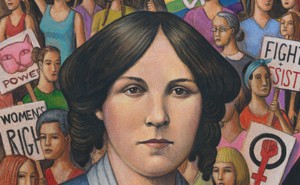The dubious notion that philosophy is a guide to calmer living is as old as the field itself. Saint Augustine described philosophy as a “harbor” for troubled souls in a fourth-century monograph on the happy life, and the sixth-century Roman senator Boethius titled the treatise he wrote while awaiting execution “The Consolation of Philosophy.” More recently, in his Philosophical Investigations (1953), Ludwig Wittgenstein suggested that the aim of philosophy is not to seek the truth but rather to provide relief—“to show the fly the way out of the fly-bottle.” Wittgenstein didn’t embrace “a single philosophical method.” Instead he concluded, “There are indeed methods, different therapies” to quiet the buzz of our puzzlement.
 HIKING WITH NIETZSCHE: ON BECOMING WHO YOU ARE
BY JOHN KAAG
Farrar, Straus and Giroux
HIKING WITH NIETZSCHE: ON BECOMING WHO YOU ARE
BY JOHN KAAG
Farrar, Straus and Giroux
Nietzsche, by contrast, had no stomach for palliatives. As John Kaag reflects in his new memoir cum philosophical excursion, Hiking With Nietzsche: On Becoming Who You Are, the German thinker aimed “to terrify rather than instruct us.” “Become who you are,” the quotation that Nietzsche chose for the epigraph of his graduate dissertation, is a line from the Pythian odes of the Greek poet Pindar. Bereft of context, this pronouncement can sound as flabbily vacant as the text of a self-help manual. After all, how could anyone fail to become who she is? Is there any instruction more trivial? The full Pindar quote, however, outlines a daunting assignment: “Learn and become who you are.” Nietzsche knew that if philosophy can serve as therapy, it’s by delivering an electric jolt to the soul.
Kaag, the philosophy-department chair at the University of Massachusetts at Lowell, began experimenting with what might be called first-person philosophy—not desiccated fodder for arcane journals but robust inquiry into what he calls the “stuff of everyday life”—in his 2016 book, American Philosophy: A Love Story.Mingling romance and scholarship, Kaag related how he stumbled onto the private library of a 20th-century philosophical eminence, then out of a miserable marriage and into the arms of his now-wife, the Kantian philosopher Carol Hay. As Kaag and Hay worked to preserve the library’s holdings, they didn’t find consolation, exactly. Instead, they grappled with transcendentalists like Ralph Waldo Emerson and pragmatists like William James. Along the way, they came to regard love as a challenge rather than a balm. In Hiking With Nietzsche, Kaag describes the draw of Nietzsche’s marital ideal—a union that embodies “the will of two to create the one that is more than those who created it,” never lapsing into “one long stupidity.”
Kaag’s latest work represents another effort to restore philosophy to its former relevance—to tether it to the mess of daily experience. Hiking With Nietzscheexplores two related but distinct reckonings with the blandishments of modern life, Kaag’s and Nietzsche’s. Kaag is fascinated by the idea of decadence—which Nietzsche first broached in The Birth of Tragedy, and which would preoccupy him for the rest of his life: “Is it perhaps possible to suffer from over-abundance?” he asked. “Is there perhaps such a thing as neuroses of health?” Blending biography, intellectual history, and personal essay, Kaag follows three related journeys: Nietzsche’s evolution from adolescent upstart to middle-aged iconoclast, Kaag’s youthful attempt to retrace Nietzsche’s footsteps through the Swiss Alps, and Kaag’s adult effort to retrace his own retracing, this time with Hay and their 3-year-old daughter in tow. The result is not just an approachable introduction to Nietzsche’s thought. Kaag’s book is also, despite its cloying title, a confirmation that philosophy thrives when it provides an antidote to the wholesome doldrums of sanity.
Nietzsche, born in 1844, led the kind of maladjusted life that contemporary therapies and self-help books are designed to rehabilitate. He was a lonely, awkward young man whose attempts to participate in the drunken revelries so prevalent at his two alma maters, the University of Bonn and the University of Leipzig, were short-lived and half-hearted. “He actually didn’t like beer,” Kaag reports. “He liked pastries. And he liked studying—a lot.”
Nietzsche’s academic career was marked by a number of dazzlingly early successes. At 24, he was the youngest tenured faculty member at the University of Basel. But by 28, he had been demoted from wunderkind to pariah, thanks in large part to the publication of his first book, The Birth of Tragedy (1872). More a work of creative interpretation than a piece of faithful exegesis, the debut departed sharply from accepted philological method, infuriating Nietzsche’s colleagues. It argued that two aesthetic tendencies vied for dominance in ancient Greece: the Dionysian, a primordial blurring of the borders dividing self and world, and the Apollonian, a rationalist paradigm that positioned art as an ordered alternative to the havoc of life. Though Nietzsche regarded these two forces as mutually enhancing—and he lauded tragedy for wedding them—his real allegiance lay with the Dionysian, as his life and work went on to attest.
The hostility that The Birth of Tragedy spawned among philologists solidified Nietzsche’s break with academic culture. In 1879, when he was 34, declining health compelled him to leave his post in Basel, and he wandered the Alps and nursed his chronic headaches for the next decade—his most miserable and most productive. His sole serious romantic interest, the author Lou Salomé, rebuffed him brutally, declining his three marriage proposals. (Salomé, whom Nietzsche once described as “the smartest person I’ve ever met,” had an enviably literary love life: She rejected not just Nietzsche but also the writer Paul Rée, and she conducted a long-standing affair with the poet Rainer Maria Rilke.)
In 1889, Nietzsche suffered the dramatic breakdown that would debilitate him until his death 11 years later: Upon catching sight of a man flogging a horse in a public square in Turin, the story goes, he threw his arms around the animal’s neck, burst into tears, and crumpled to the ground. He had already displayed signs of volatility before this collapse. According to Kaag, Nietzsche “began to sign his letters ‘Dionysus’ ” in 1888, and he had a troubled relationship with food throughout his life, ricocheting from one extreme diet to the next. As he grappled with the specter of decadence, his austere and itinerant life represented a rejection of the indulgent spirit dulling the haute bourgeoisie of fin de siècle Europe.
At 19, Kaag shared Nietzsche’s distaste for the “scripted” routines and glib gratifications that make modern life so deplorably easy. When he arrived in Basel on a research trip, he recoiled at his surroundings: The train station was “a model of Swiss precision,” and the streets were “too straight, too quiet, too mundane.” He quickly abandoned his plans to ruminate on Nietzsche from the confines of Basel’s library and instead decided to follow his idol’s grueling alpine route to “Splügen, then to Grindelwald at the foot of the Eiger, then to the San Bernardino Pass, to Sils-Maria, and finally to the towns of Northern Italy.” He wanted, he writes, “to feel something, to break through the anesthesia, to prove to myself that I wasn’t just asleep.”
How did “Nietzsche cultivate the existential defiance or courage that led [him] up the mountain?” Kaag asks.
It probably started something like this—in a very simple refusal to act on behalf of one’s obvious self-interest. There remains a life-affirming glee in such a refusal—a quiet temptation that even the most well-adjusted person feels at various points.
As Kaag advanced along Nietzsche’s trek, his refusal started to take the form of fasting so intense, it often left him dizzy. When he finally relented, he stumbled into a luxury hotel and ordered a sickeningly opulent multicourse meal.
His reversal was radical—and, in some ways, utterly Nietzschean: “The spell that fights on our behalf, the eye of Venus that charms and blinds even our opponents, is the magic of the extreme, the seduction that everything extreme exercises,” Nietzsche wrote in The Will to Power, the posthumously published book that many consider his magnum opus. This core provocation, the heart of his teachings and his notoriously hyperbolic style, is by turns enthralling and juvenile.
Mercifully, 37-year-old Kaag is aware of the raw, adolescent quality of some of Nietzsche’s most radical insights, and he acknowledges that during his own infatuation with his hero he was “thoroughly intolerable.” Still, he isn’t entirely immune to the seductions of Dionysian extremity. When he revisits the Swiss town of Sils-Maria 18 years after his initial trip, he both laments and celebrates his maturation. He smiles for a family photo and entertains fleeting worries that he has become “a grinning domesticated animal,” one of the pampered. How to resist? When he heads back to his family after a day of lonely hiking, he reflects, “Perhaps a pilgrim triumphs not in hardship, but in the rare moment when they learn to accept something soft at home.” This sounds like an un-Nietzschean lesson, and Kaag’s clichés can sometimes leave us wondering whether he embraces Wittgenstein’s vision of philosophy after all.
But to Kaag’s credit, he is determined to inject hints of extremity into his outwardly stable life. By the time he returns to America, he has modified his conception of how, exactly, we should go about steeling ourselves in the face of the decadent imperatives of a consumerist, conformist world. What Kaag overlooked in his youth is that Nietzsche does not prescribe difficulty for its own sake. Though the metaphorical language Nietzsche employed throughout his career is wildly inconsistent, he was ultimately an advocate of health—but health, he emphasized, is not synonymous with enjoyment. On the contrary, health requires the trials that beget a strong constitution (and Nietzsche did not have SoulCycle in mind). In The Will to Power, he wrote,
To those human beings who are of any concern to me I wish suffering, desolation, sickness, ill-treatment, indignities—I wish that they should not remain unfamiliar with profound self-contempt, the torture of self-mistrust, the wretchedness of the vanquished: I have no pity for them, because I wish them the only thing that can prove today whether one is worth anything or not—that one endures.
Kaag needed two trips to the Alps to grasp that Nietzsche counsels us to celebrate our suffering because we can avoid it only if we avoid engagement—only if we insulate ourselves from the hardship that is part and parcel of even the most placid human existence. Kaag concludes that a celebration of life needn’t entail self-immolation, but it necessarily entails difficulty. “The self does not lie passively in wait for us to discover it. Selfhood is made in the active, ongoing process, in the German verb werden, ‘to become,’ ” he writes.
Life goes on for Kaag, of course, and the threat of complacency looms: “Syllabi were dutifully written. Conferences were studiously organized. Bathrooms were meticulously cleaned.” But Kaag resists—not by fasting or hiking mountains in inadequate footwear but by recalling as often as possible, in the intervals between deadening and dulling, that “things must suffer, go dark, perish before they live again. This is not an escape or respite from life but rather its realization.” Kaag may have outgrown his youthful dramatics, but he continues to let philosophy upend him. It once took him all the way to the edge of an Alpine precipice, to the brink of starvation. It went on to undo one marriage and inspire another. And it continues to heal us, not by making us feel better, but by making us well.
 HIKING WITH NIETZSCHE: ON BECOMING WHO YOU ARE
BY JOHN KAAG
Farrar, Straus and Giroux
HIKING WITH NIETZSCHE: ON BECOMING WHO YOU ARE
BY JOHN KAAG
Farrar, Straus and Giroux



